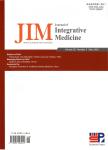DIVERGENT EFFECT OF EXPECTANCY ON TREATMENT RESPONSE BETWEEN REAL AND SHAM ACUPUNCTURE
DIVERGENT EFFECT OF EXPECTANCY ON TREATMENT RESPONSE BETWEEN REAL AND SHAM ACUPUNCTURE作者机构:Perelman School of Medicine at University of Pennsylvania
出 版 物:《Journal of Integrative Medicine》 (结合医学学报(英文))
年 卷 期:2014年第3期
页 面:223-224页
学科分类:1005[医学-中医学] 100512[医学-针灸推拿学] 10[医学]
主 题:SA DIVERGENT EFFECT OF EXPECTANCY ON TREATMENT RESPONSE BETWEEN REAL AND SHAM ACUPUNCTURE
摘 要:Background: Expectancy has been hypothesized as a critical component of the placebo response; however, change in expectancy during acupuncture trials has not been previously evaluated.We sought to evaluate the relationship between expectancy and treatment response in both real and sham acupuncture.Methods: We analyzed data from a recently completed randomized controlled trial using real electroacupuncture(EA) and sham acupuncture(SA).The trial was conducted among 67 women with stage I-III breast cancer who experienced joint pain attributable to aromatase inhibitors.Responders were classified as those who reported much improved or very much improved on the Patient Global Impression of Change instrument at week 8(End of intervention).The Acupuncture Expectancy Scale(AES), a validated instrument, measured expectancy at baseline, week 2, 4, and 8.In this scale, a higher score indicates a greater degree of expectancy.Results: Responders in the SA group had higher expectancy at baseline than non-responders(15.5 vs.12.1, P=0.005).Expectancy remained higher in SA responders through the end of intervention(16.0 vs.11.4, P=0.035).Responders and non-responders in the EA group, by contrast, did not have different expectancy levels at baseline(14.8 vs.15.3, P=0.64).By the end of the intervention, however, EA responders had significantly higher expectancy than non-responders(16.2 vs.11.7, P=0.0038).Conclusion: The relationship between expectancy and treatment response is distinct between real and sham acupuncture.Our findings suggest that while higher outcome expectancy predicts treatment response in sham acupuncture, such a predisposition is not associated with the response to electro-acupuncture.Once patients develop a response to real acupuncture, their expectancy rises significantly.These findings have important implications for both acupuncture research and clinical practice.



